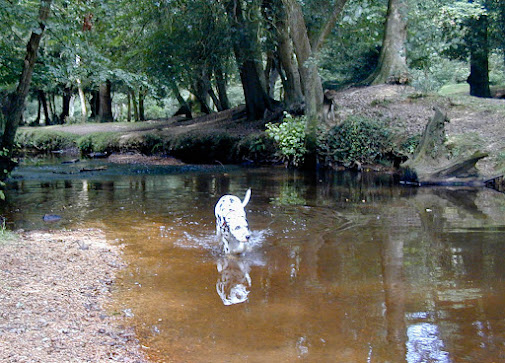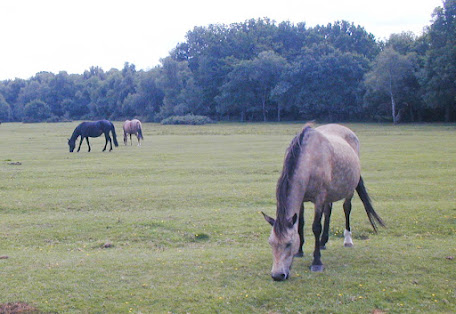The New Forest
Dominie in the New Forest, many years agoThis ancient forest covers 140,000 acres of pasture, heath and forest in south-west Hampshire and south-east Wiltshire in the south of England. William the Conqueror decreed it a royal forest in 1079 for the purpose of hunting ‘the beasts of the chase’ - that is, the two native deer, the red and the roe, wild boar, and the fallow deer which were introduced by the Normans after 1066.
The New Forest was recorded in the Domesday Book, which was a survey and valuation of land and property in England. It was commissioned by William the Conqueror in 1085 and completed in 1086. The Domesday Book is actually two works – the Great Domesday, which was probably written on parchment by just one person and the Little Domesday, which had at least six people working on it.
New Forest poniesIt is home to the New Forest Commoners, who continue to exercise their ancient rights of common pasture. Anyone living in the forest has the right to turn their animals out to graze for pasture and is thus known as a Commoner. Their rights are protected by verderers and agisters. The Court of Verderers are unpaid officials who oversee commoner rights, such as the grazing of ponies, and ensure the protection of land and wildlife.
From Wikipedia:
The Court has the same status as a Magistrates Court, and acting under its authority the Verderers are responsible for regulating commoning within the Forest, for dealing with unlawful inclosures, and for a wide range of other matters relating to development control and conservation such as proposals for new roads, car parks, camping sites, recreational facilities, playing fields and so on.
The agisters are a small group of people who help the verderers in monitoring the free-roaming animals which graze the Forest. They spend much of their time on horseback, checking the land and the animals. There are several thousand semi-feral ponies as well as many thousand cattle to oversee. Sheep and donkeys are also turned out to graze, though in lesser numbers. In the autumn, pigs are turned out for about 60 days to feed on acorns, beechmast and other nuts. This practice is known as pannage.
Homeward bound
The drift provides an opportunity to worm the ponies and brand the new foals, each owner having a distinctive brand. This is the time that ponies may be withdrawn for sale or taken in for the winter. The ponies that are to be turned out for another year have their tails clipped in a style that identifies them as belonging to a particular agister’s area of the forest.
Pony tail cutsCourtesy of New Forest Show, 2012
Someone once remarked that the ponies’ tails look as though they’ve had a bad haircut, but they are clipped to prove that their owners have paid the marking fee for the coming year.
Because the animals are free to roam, they often wander onto unfenced roads. There is a speed limit through the unfenced areas but accidents happen, because drivers do not adhere to the speed limit. Last year, 2022, 41 animals died, either killed outright, or destroyed because they were too badly injured to survive. The unfortunate animals were 34 ponies, 3 pigs, 2 cows and 2 donkeys. Nineteen more were injured but lived to tell the tale.







.png)

